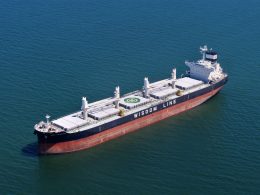Supertankers are not only the largest ships to ever sail the seas, they are the largest moving constructs created by man. Other than VLCCs this category of vessels includes ULCCs (Ultra Large Crude Carriers).
While ULCCs are virtually extinct due to their exaggerated size that makes them unusable in numerous ports, canals, and sea lanes, VLCC tankers are thriving, being vessels of choice for most charterers receiving crude oil from the Persian Gulf area.
How Big Are VLCCs?
An average VLCC is 60 meters (197 feet) wide, 330 meters (1 100 feet) in length, and is able to carry about two million barrels of oil (84 million US gallons, 318 million liters).
In other words, one ship alone carries approximately enough oil to satisfy the daily consumption of the entire country of South Korea.
One VLCC alone can carry approximately enough oil to satisfy the daily consumption of the entire country of South Korea.
In comparison, one of the largest container ships ever created, the infamous Ever Given (recently stuck in the Suez Canal), is approximately the size of the smallest VLCC. Ever Given is 400 meters long, which makes it longer than a VLCC, but its Dead Weight Tonnage (DWT) is about 200 000, while VLCCs usually have DWT between 200 000 and 320 000.
VLCC’s size is its prime advantage but also its biggest disadvantage. Even after widening works in 2016, the Panama Canal is still unable to receive these huge vessels. In addition, a fully laden ship of this size has a draught of up to 20 m (66 feet), which makes it unable to enter many shallower ports.
For this reason, VLCCs conduct cargo operations and replenishment at sea or at off-shore terminals. Some countries, like the USA, have legislation that prevents this type of ship from entering their ports or even territorial waters, out of ecological and safety concerns.
In other words, these ships spend most of their time at sea and all of their voyages are international and usually transoceanic in nature.
How Do VLCCs Enter a Port?
Even on those rare occasions when a VLCC enters a port the crew can hardly expect a port call.
First of all, such facilities are expensive and operate on a tight schedule. This means that a ship will not stay in port any longer than it needs to on-load or off-load cargo. In addition, most ships operate only with essential personnel (20-30 crew members), which means there are no hands to spare during cargo operation.
Life aboard a VLCC
That being said, even though life on tankers is no leisure cruise it does not mean that it is an “all work – no play” experience. As per the Maritime Labor Convention (2006), shipping companies are obliged to give sufficient rest to their mariners in order to avoid exhaustion-related injuries and mistakes.
Cabins
Considering the size of VLCCs it should come as no surprise that they usually have spacious cabins for their crew. Most often it is a single-bedroom with its own bathroom, the size varies depending on the rank of a mariner.
Leisure
In addition to communal dining rooms, separate for officers/engineers and ratings, VLCCs feature leisure rooms usually containing a TV, gaming consoles, books, magazines, and board games. Most VLCC ships have their own gyms and those better equipped have small swimming pools and saunas.
Most VLCC ships have their own gyms and those better equipped have small swimming pools and saunas.
Taking into consideration that crewmembers usually stay aboard 3-6 months ships of this kind have a small store where one can buy toiletries, snacks, and soft drinks. In addition to this, there is usually an option to order from ship-chandlers a wide variety of items that can be purchased upon collection at a later date (usually during cargo operations). Sunday is usually a day off for the engineers (except for the one on duty) due to automation that allows engine rooms to remain unmanned even when in operation.
Engineers Aboard a VLCC
When it comes to engineers aboard VLCCs there are usually four of them, accompanied by oilers, wipers, a mechanic/fitter, and sometimes an additional Electrical Engineer/Officer.
VLCCs Engineer Ranking System
The most common ranking system in a marine engine room has a Chief Engineer, 1st Assistant Engineer, 2nd Assistant Engineer, and a 3rd Assistant Engineer.
Some companies employ an alternative structure where the 1st Engineer is in the role of the Chief Engineer, thus having a 2nd Engineer, 3rd Engineer, and a 4th Engineer (who in this command structure acts as the 3rd Assistant Engineer does in the first one).
Duties that engineers perform aboard VLCCs may slightly vary from one shipping company to another but there are no significant differences.
Chief Engineer
Chief Engineer is in charge of the entire engine department, he is responsible for all the people and equipment in the engine-room. Chief Engineer decides major jobs within the engine-room.
First Assistant Engineer
The First Assistant Engineer further allocates to other engineers and ratings. Other than having a managerial job the First Assistant Engineer is also responsible for the work and maintenance of the main engine, steam system (boilers and turbines), steering gear system, and overall safety systems of the ship.
Second Assistant Engineer
The Second Assistant Engineer is responsible for auxiliary engines (ship’s electricity generators), fresh water generators, refrigeration and air conditioning systems, as well as pumps.
Third Assistant Engineer
The Third (Assistant) Engineer is in charge of bunkering operations (fueling the ship), fuel and lube oil purifiers, and air compressors.
Watchkeeping
Other than the Chief Engineer, all other ranks are watchstanding positions. The watchstanding system is maintained during cargo operations, major engine maneuvers, and in areas of dense traffic (such as straits or canals). Watches last 4-6 hours depending on the company’s policy.
Working Environment at a VLCC
High Temperature
While most major equipment can be directed from the engine control room, scheduled maintenance and repairs are conducted in the engine room.
Since main propulsion on a VLCC is usually an immensely powerful slow-speed two-stroke engine, that runs both on heavy fuel oil and marine diesel (depending on the area of operation), high temperatures are developed in the engine room.
There are cooling systems aboard but they are dependent on seawater temperature, which in the Persian Gulf area (where VLCCs most commonly get their cargo) tends to be quite warm throughout the year.
Protective Equipment
In addition to high temperatures, an engineer aboard a VLCC is obliged to constantly wear personal protective equipment in order to avoid injury from many potential hazards.
This combination of difficult working conditions creates a harsh working environment making the calling of a marine engineer reserved only for some of the most determined men and women.
This combination of difficult working conditions creates a harsh working environment making the calling of a marine engineer reserved only for some of the most determined men and women.
How To Become A Shipboard Engineer?
Education
In order to become a shipboard engineer one must acquire technical skills and knowledge in a STCW (International Convention on Standards of Training, Certification and Watchkeeping for Seafarers) certified course of study.
Many countries train their mariners, both deck officers, and engineers, in specialized maritime academies and colleges. Education in these institutions typically lasts 3-4 years and graduates receive bachelor’s degrees along with their STCW certification needed to work aboard.
However, more numerous are maritime training centers where education is significantly shorter (usually around six months) but enables graduates to work aboard nonetheless. Although training centers initially save time mariners trained in such a manner require additional education in order to advance beyond the rank of 2nd Assistant Engineer.
Cadetships
School and certification alone is not enough to make one an officer or a marine engineer. Graduates fresh out of training are required to spend 12 months aboard a ship (usually in two six-month installments) as engineering cadets in order to learn on-job what will be required of them when they become fully-fledged engineers. The cadetship is a sort of internship for the upcoming engineers.
The cadetship is a sort of internship for the upcoming engineers.
So-called Oil majors (or Big Oil), largest oil production companies such as BP, Chevron, Royal Dutch Shell, and similar, have their own VLCC fleets and are a common destination for those interested to work as marine engineers.
In addition to these, there are many other companies that deal solely in shipping and have a significant number of VLCC ships. Most prominent among these are Mitsui O.S.K. Lines, NYK (Nippon Yusen), Frontline Ltd, Maersk, but there are many others.








